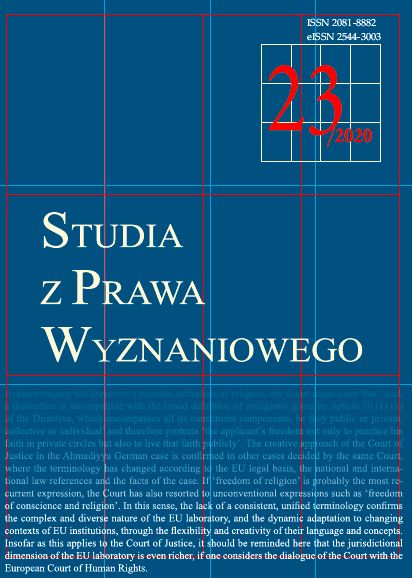Zgodność granic administracji kościelnej z granicami odrodzonego państwa polskiego w konkordacie między Stolicą Apostolską a Rzecząpospolitą Polską z 1925 r.
The conformity between the borders of the church administration and the borders of the reborn Polish state in the Concordat between the Holy See and the Republic of Poland of 1925
Author(s): Piotr RygułaSubject(s): Law, Constitution, Jurisprudence, History of Law, Constitutional Law, Canon Law / Church Law, Administrative Law
Published by: Katolicki Uniwersytet Lubelski Jana Pawła II - Wydział Prawa, Prawa Kanonicznego i Administracji
Keywords: konkordat; II Rzeczpospolita Polska; Kościół Katolicki; administracja kościelna; Catholic Church; Concordat; Polish Concordat of 1925; church administration; church – state relations;
Summary/Abstract: The Second Polish Republic was a state that put a special emphasis on the safety of its political borders and on the integration of the people living on the territory of the reborn state. The guarantee to adjust the new canonical administrative division of the Catholic Church in Poland to the political borders of the new state, which was included in Article 9 of the Concordat of 10 February 1925, was of special importance to the Polish Republic at the beginning of its statehood. On the basis of the idea of the separation of church and state, the present article aims to show how the canon-law instruments were applied to achieve the goal of the territorial and social integration of the Second Polish Republic. The signatories of the Concordat were obviously aware of the fact that the legal instruments at the disposal of the Holy See were canon-law instruments. As such, they were not appropriate to confirm or guarantee the shape of the political borders of the state. However, the fact that they made it possible to map the existing political borders of the state onto the canonical chart of the contemporary Catholic Church in Europe is undeniable. When it comes to the integration of the Polish people, it was not possible to overlook the fact that the Roman Catholic Church was “the religion of the preponderant majority of the nation” in the Second Polish Republic, as stated in Article 114 the Constitution of 1921. Thus, the integration of the structures of the Catholic Church was of fundamental importance not only to its own efficiency within the borders of the state, but also to the social integration of the country, where 75% of the people declared the Catholic faith.
Journal: Studia z Prawa Wyznaniowego
- Issue Year: 2020
- Issue No: 23
- Page Range: 277-305
- Page Count: 29
- Language: Polish

